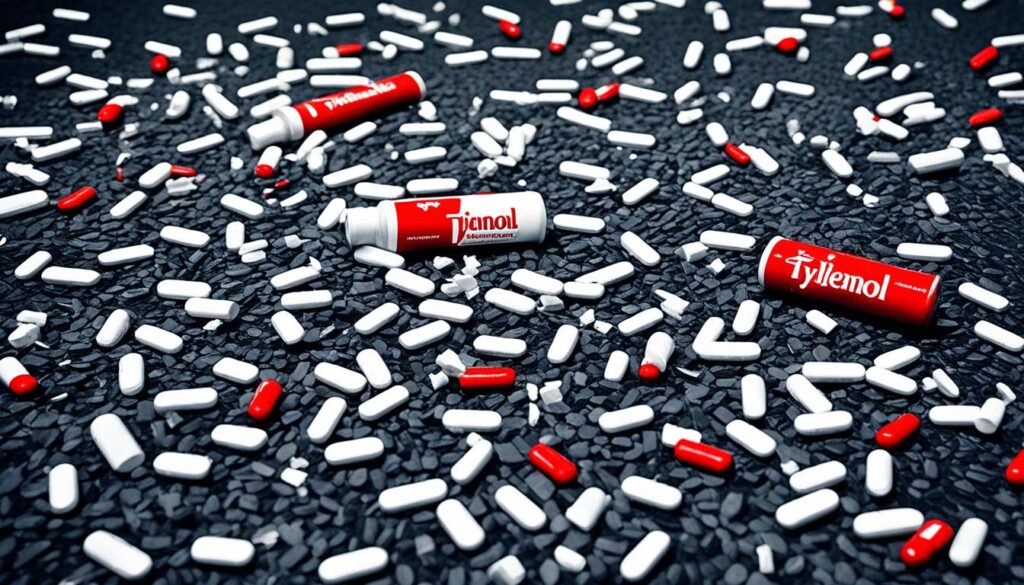Have you ever thought about how big companies recover from big PR crises? In today’s world, managing your reputation is key to success. Companies like Starbucks and Johnson & Johnson faced big challenges but came out on top1.
These stories of recovery show us how to handle a brand’s image when things go wrong. We’ll see how quick actions and clear talks helped these companies grow and regain trust1.
Research shows that strong reputation management leads to better financial health1. Some strategies have even seen a 90% success rate2. This highlights how crucial good crisis management is for businesses today.
Let’s look at these interesting case studies. We’ll see what made their reputation recoveries successful. You might be amazed at how a single star on review sites can boost sales and change how people see a company3.
Key Takeaways
- Good reputation management can improve a company’s finances
- Quick action and clear communication are vital in crises
- Recovering reputation can mean closing stores or recalling products
- Online reviews and ratings greatly affect a company’s earnings
- Being proactive and consistent in communication helps rebuild trust
Understanding the Imperative of Reputation Management
In today’s digital age, having a good corporate reputation is key for businesses. A whopping 87% of top executives see managing reputation risk as a top priority4. This shows how crucial a strong reputation is for a company’s success and trust with customers.
Brand awareness is crucial for a good reputation. Research shows that 73% of shoppers are more likely to choose a brand they know5. Social media and review sites let people share their thoughts, with 93% checking reviews before buying something5.
How a company handles crises and talks openly is vital for its reputation. Companies with a good name can bounce back faster from tough times4. Answering negative comments well can lessen harm and show you care about customers6.
A company’s reputation affects more than just how customers see it. It also impacts employee happiness, with 84% thinking of leaving for a better-known company5. A strong reputation means customers stick around, which can greatly increase profits5.
| Aspect | Impact on Business |
|---|---|
| Brand Recognition | 73% higher consideration by consumers |
| Customer Retention | 5% increase can lead to 25-95% profit boost |
| Price Premium | Up to 16% for trusted brands |
| Employee Satisfaction | 84% link to company reputation |
New tech like augmented reality and AI offer chances to improve customer interaction and make experiences more personal6. These changes highlight the importance of businesses being ahead in managing their online image and keeping a positive reputation.
Successful Reputation Recovery Stories: Real-World Examples

Real-world case studies show how companies bounce back from reputation crises. Many companies have faced big challenges and come out on top with smart brand restoration plans. Let’s look at some examples of successful public relations and crisis management.
Volkswagen’s 2015 emissions scandal cost them €30 billion and affected 11 million vehicles worldwide7. They tackled this by saying sorry, recalling cars, and investing in electric vehicles to gain trust back.
KFC was hit hard when a chicken supplier let them down, causing many stores to close. They handled it well with humor, bonuses for customers, and a clear plan to fix the problem7.
Apple was on the brink of bankruptcy in 1997 but got a $150 million boost from Microsoft. They turned things around with new products and smart marketing8. Now, Apple is a top brand worldwide.
The LEGO Group faced financial issues but turned things around by working with game and film companies. The success of The Lego Movie in 2014 helped a lot8. LEGO is now one of the most respected companies for three years running9.
These stories show the power of quick action, being open, and coming up with new ideas in handling reputation crises. They prove that with the right steps, companies can not just recover but come out stronger and more resilient.
The Starbucks Racial Bias Incident: A Lesson in Swift Action
In April 2018, Starbucks faced a major crisis that shook its reputation. Two black men were arrested at a Philadelphia store, causing widespread outrage and calls for boycotts. This incident showed the need for effective crisis management and corporate responsibility10.

Starbucks, a global coffee giant with over 28,000 stores worldwide, was caught in a racial bias storm1110. The company quickly responded with key steps for brand recovery:
- Immediate public apology from CEO Kevin Johnson
- Commitment to concrete action
- Transparent communication with stakeholders
In a bold move, Starbucks closed more than 8,000 U.S. stores on May 29 for racial bias education training1210. This affected around 175,000 employees, showing the company’s commitment to the issue.
“We’re taking a hard look at who we are as a company. We’re ashamed and recognize that racial bias is a problem we must address.” – Kevin Johnson, Starbucks CEO
The incident and Starbucks’ response teach us a lot about managing a reputation:
| Action | Impact |
|---|---|
| Swift public apology | Demonstrated accountability |
| Store closures for training | Showed commitment to change |
| Transparent communication | Built trust with stakeholders |
| Long-term action plan | Ensured sustained improvement |
This case shows the power of quick action, clear communication, and a long-term plan in handling corporate crises. By tackling the racial bias incident directly, Starbucks set a new standard for crisis management and corporate responsibility under public scrutiny.
Johnson & Johnson’s Tylenol Crisis: Setting the Gold Standard
In 1982, Johnson & Johnson faced a crisis that changed how companies handle such situations. Seven people in Chicago died after eating Tylenol capsules laced with cyanide. This event shocked the nation, with over 90% of Americans learning about it within a week13.
J&J acted fast and with clarity. They pulled $100 million worth of products from the market, putting safety first14. They set up a hotline for worried consumers and spoke openly about their actions. Through media, they reached 90% of the US population14.

The crisis hit J&J hard. Before the crisis, Tylenol made up 19% of J&J’s profits and had a 37% share in painkillers13. The recall and destruction of over 30 million bottles cost about $100 million14.
J&J showed their commitment to safety and trust in their actions. Within six weeks, they created new tamper-resistant packaging, a first in the industry, and brought back Tylenol14. This move set new standards in handling crises and corporate ethics.
The company’s recovery was impressive. A year after the crisis, J&J had regained 30% of its market share14. The Tylenol case is now seen as the gold standard in crisis communication, influencing strategies for the past 20 years13.
| Aspect | Before Crisis | During Crisis | After Crisis |
|---|---|---|---|
| Market Share | 37% | Significant Drop | 30% Regained |
| Corporate Profits | 19% of J&J’s Profits | $100 Million Loss | Gradual Recovery |
| Public Awareness | Limited | 90% of Americans Aware | Positive Brand Image |
Conclusion: Key Takeaways for Effective Reputation Recovery
In today’s digital age, managing your reputation is key. Nine out of ten customers check reviews before buying, showing how important a good brand image is15. Companies with a strong positive reputation offer more value, attract better talent, and keep customers loyal16.
Being ready for a crisis helps your brand bounce back. A single negative event can turn into a big crisis, hurting your business and maybe even closing it15. To avoid this, focus on managing your reputation well and acting fast in a crisis. Being open and honest with everyone helps rebuild trust.
Building a good reputation takes constant work and being flexible. With over 65% of business leaders saying social media can make a brand crisis worse17, having strong online communication is vital. By doing what you say you will and being ethical, you can keep your reputation strong through tough times and achieve long-term success.
FAQ
What is reputation management and why is it important?
What are some proactive measures for reputation management?
How did Starbucks handle the racial bias incident in 2018?
What can we learn from Johnson & Johnson’s handling of the 1982 Tylenol crisis?
How can companies effectively manage their online reputation?
What are the key components of a successful reputation recovery strategy?
Source Links
- Reputation Management Case Studies: Big Brand Turnarounds – https://bryghtpath.com/reputation-management-case-studies/
- Online Reputation Management Testimonials andCase Studies – https://www.recoverreputation.com/online-reputation-success-stories-and-case-studies/
- Company Reputation Assessment: Case Studies: Successful Company Reputation Assessment Strategies – FasterCapital – https://fastercapital.com/content/Company-Reputation-Assessment–Case-Studies–Successful-Company-Reputation-Assessment-Strategies.html
- Crafting a Path to Effective Corporate Reputation Enhancement – https://holistiquetraining.com/news/crafting-a-path-to-effective-corporate-reputation-enhancement
- The Impact of Brand Reputation on Business Success – https://trainual.com/manual/brand-reputation
- Branding and Reputation Management in the Digital Age – https://onlinedegrees.scu.edu/media/blog/branding-and-reputation-management-in-the-digital-age
- Reputation crisis management: top-5 cases – https://youscan.io/blog/reputation-crisis-cases/
- Launch Your Own Reputation Management Platform – https://reviewgrower.com/companies-that-have-rebuilt-their-reputation/
- These Companies Have the Best Corporate Reputations in the World | RepTrak – https://reptrak.com/blog/these-companies-have-the-best-corporate-reputations-in-the-world/
- The Starbucks Incident: a crisis management case study – https://www.bernsteincrisismanagement.com/the-starbucks-incident-a-crisis-management-case-study/
- $16.7 Million To Save One Reputation: How Starbucks Responded Amidst a Racial Sensitivity Crisis – https://digitalcommons.pepperdine.edu/cgi/viewcontent.cgi?article=1108&context=pjcr
- What are some reputation management success stories, and what can you learn from them? – https://www.linkedin.com/advice/0/what-some-reputation-management-success-stories-x9c6c
- Untitled Document – https://www.ou.edu/deptcomm/dodjcc/groups/02C2/Johnson & Johnson.htm
- Recovering from disaster: How smart companies handle a PR crisis – https://www.linkedin.com/pulse/recovering-from-disaster-how-smart-companies-handle-pr-neil-petch
- Reputation crisis: How to recover from a damaged image – https://www.vendasta.com/blog/reputation-crisis/
- Reputation and Its Risks – https://hbr.org/2007/02/reputation-and-its-risks
- How to Recover from a Reputation Crisis and Rebuild Your Brand – Prowly – https://prowly.com/magazine/brand-reputation-crisis/

